After we had the first two dozen Project TinyMiniMicro machines arrive in the lab, we were alerted to a deal for a Lenovo ThinkCentre M90n or M90n-1 Nano. While the Project TinyMiniMicro machines are 1L, the M90n offers something that the larger nodes cannot, extreme compactness. At only 0.35L, we were hoping the M90n would do in the Nano form factor what we had seen the Tiny form factor fill, just in less space. That was an incorrect assumption. While William did our Lenovo ThinkCentre M90n Nano Review, we are going to discuss why we can only recommend the M90n Nano in an extremely narrow use case as a cluster PC. Otherwise, it is absolutely the wrong choice.
Project TinyMiniMicro Background
In Project TinyMiniMicro we are purchasing a large number of these devices from different sources. While a standard STH review is of a new product, these TMM nodes occasionally have specs that differ from what one would expect. In all of these pieces, we are going to talk about what makes the nodes unique. We are now well over 30 different nodes to increase diversity. We are testing these on a more circular economy/ extended lifecycle basis to see how they can be deployed after their initial use as corporate desktops. As always, we have a video version of this article.
We recommend opening this video in a YouTube tab/ app for a better viewing experience.
For our $399, we received a node with an Intel Core i5-8365U, 8GB of memory, WiFi, and a 512GB NVMe SSD. We even got an embedded Windows 10 Pro license which would have cost us around $140 alone. Since this was a new unit, we received a 1-year onsite warranty from Lenovo at that price.
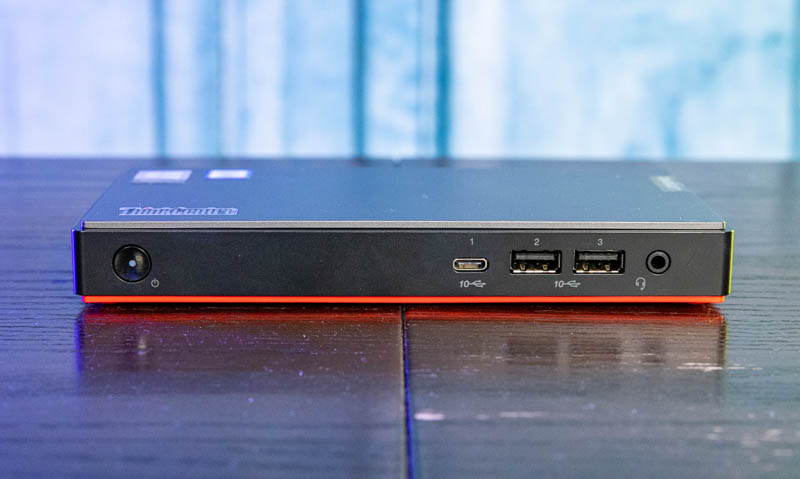
That price was good, but it is not the least expensive unit we have looked at. We have seen new units such as the Dell OptiPlex 3070 Micro Review at significantly lower prices. On the used market, many of the Core i5-8500T units we have purchased with 16GB of memory have been in the $300 range.
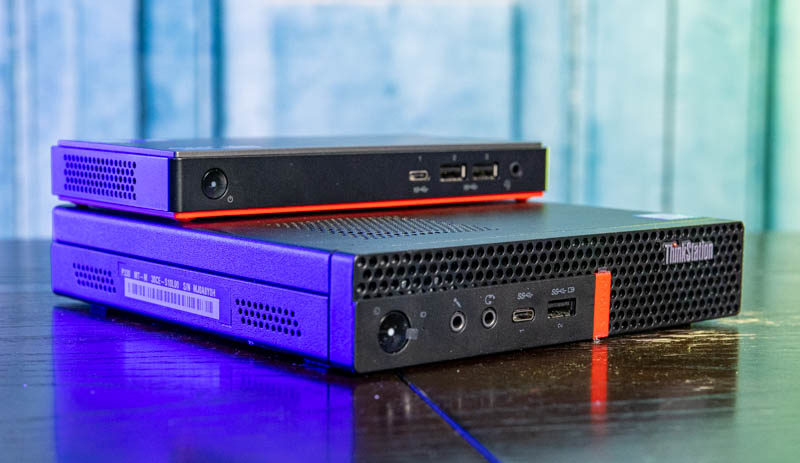
We will note also that we looked at the Lenovo ThinkCentre M90n-IoT which is a fanless version of this system with dual 1GbE NICs and at half the price (we purchased that for $199.) As part of Project TinyMiniMicro, we are looking for value so at $399, we need to justify that price tag.
We are going to go into a quick hardware overview, then into the key specs. We are then going to talk a bit about performance and power consumption before getting to our lessons learned from these units and our final words.
Lenovo ThinkCentre M90n Nano Hardware Overview
The Lenovo ThinkCentre M90n-1 Nano itself is very small, measuring only 0.35L, excluding the power supply. That makes it around a third of the volume of one of the company’s ~1L PCs.)
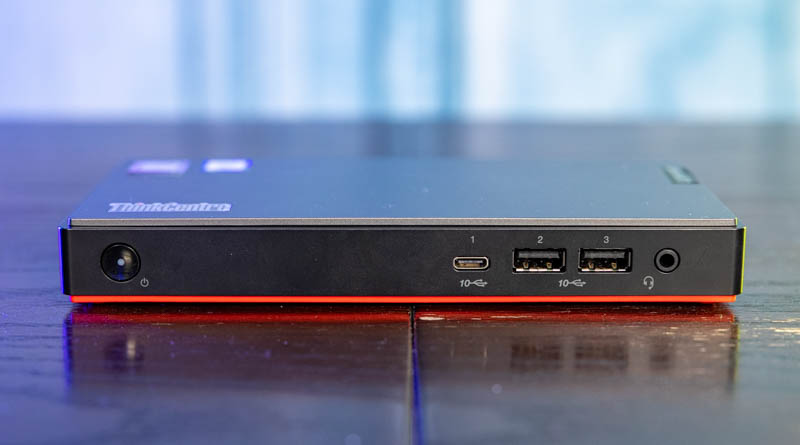
Aside from the power button, we get a headset port on the front of the system. Perhaps the bigger feature is the USB set. We get three USB 3.1 Gen2 ports. Two are Type-A ports and one is Type-C.
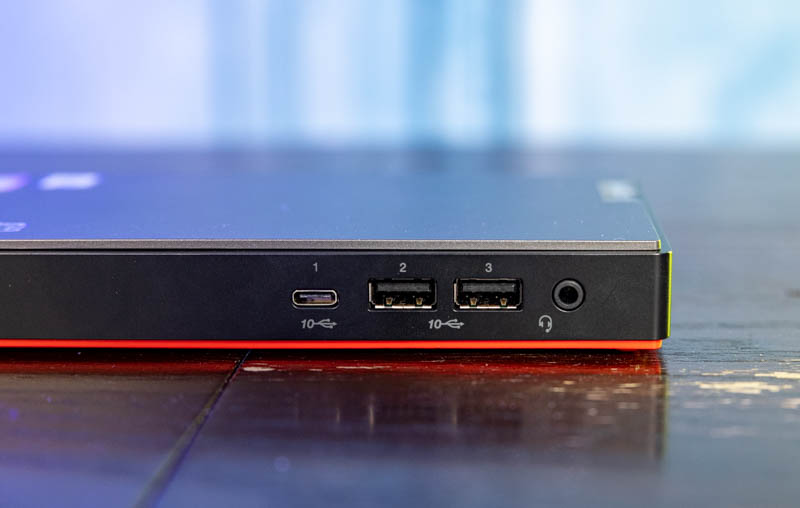
On the rear of the unit, we can see some immediate trade-offs. We get a power input followed by a DisplayPort. We will note quickly that with Project TinyMiniMicro 1L nodes we generally get two standard dedicated display outputs and one optional slot.
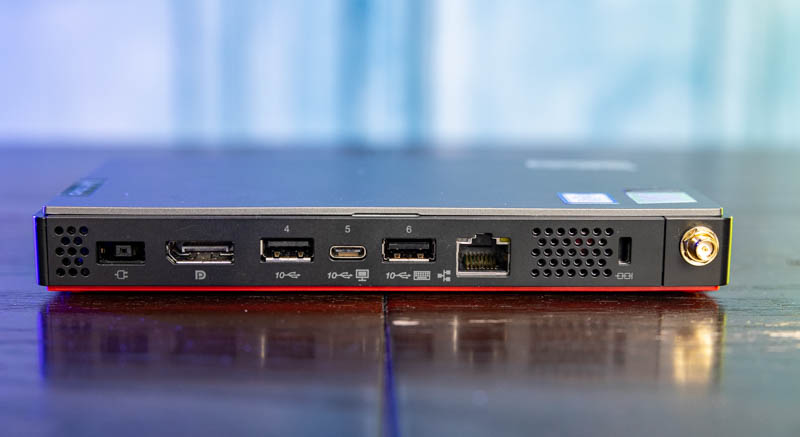
We get a total of three USB 3.1 Gen2 10Gbps ports. One can alternatively be used with a USB Type-C to DisplayPort dongle to provide a second display output.
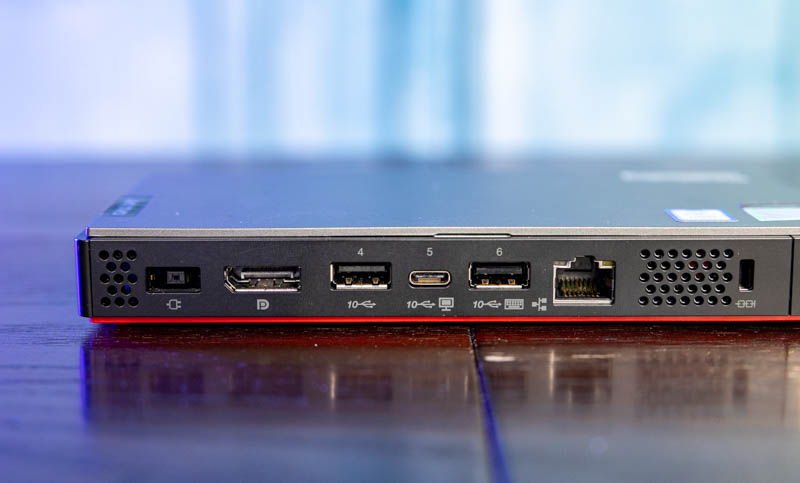
We also get a single Intel i219-LM 1GbE NIC. This is common on Project TinyMiniMicro nodes, but the passively-cooled M90n-IoT we looked at had two 1GbE Realtek NICs.
Opening the system the top cover shows us very little underneath.
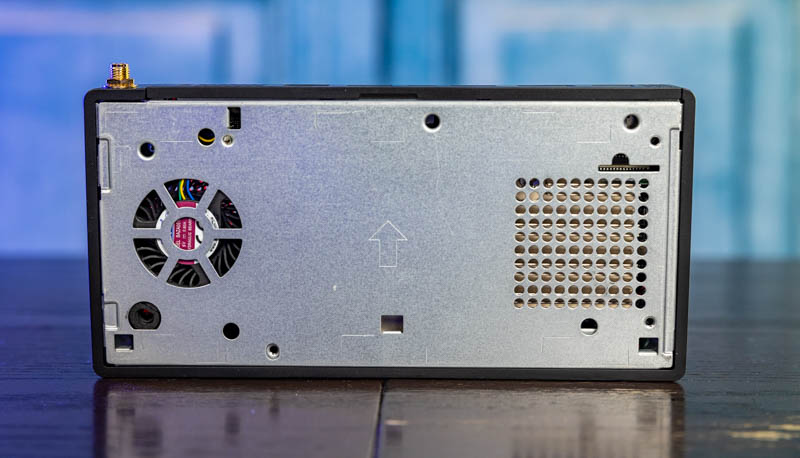
The bottom is a different perspective as we see most of the easily replaceable components.
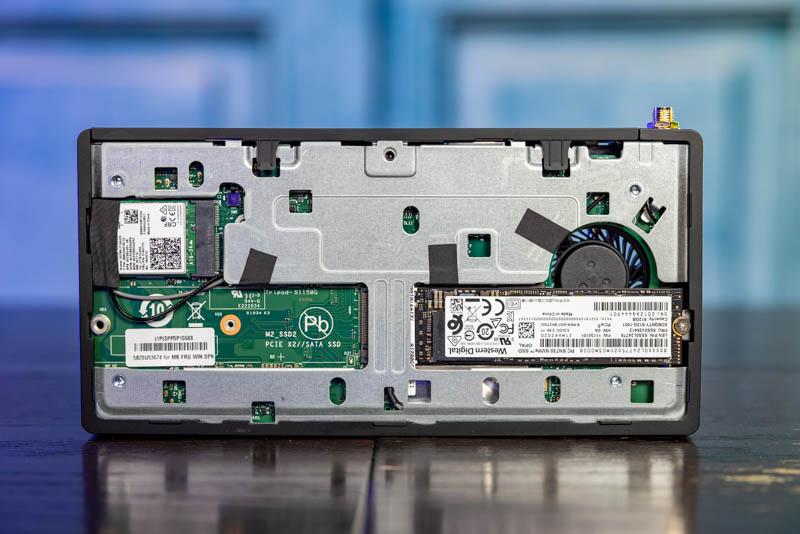
We get two M.2 SSD slots. One has a WD 512GB NVMe SSD. There are other capacity options, but this is what our unit had.
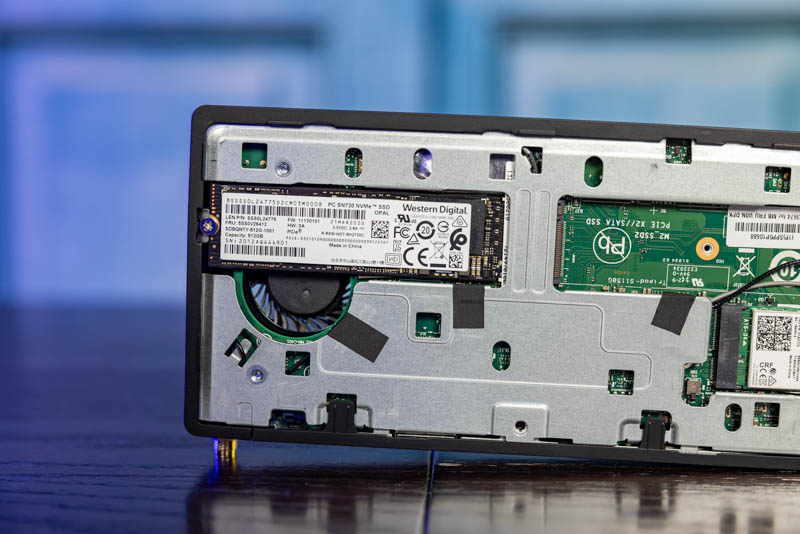
On the opposite side, we see another M.2 slot. This can be used with SATA or NVMe SSDs. If one does use a NVMe SSD, it should be noted that this is only a PCIe Gen3 x2 slot, not a x4 slot so performance is limited.
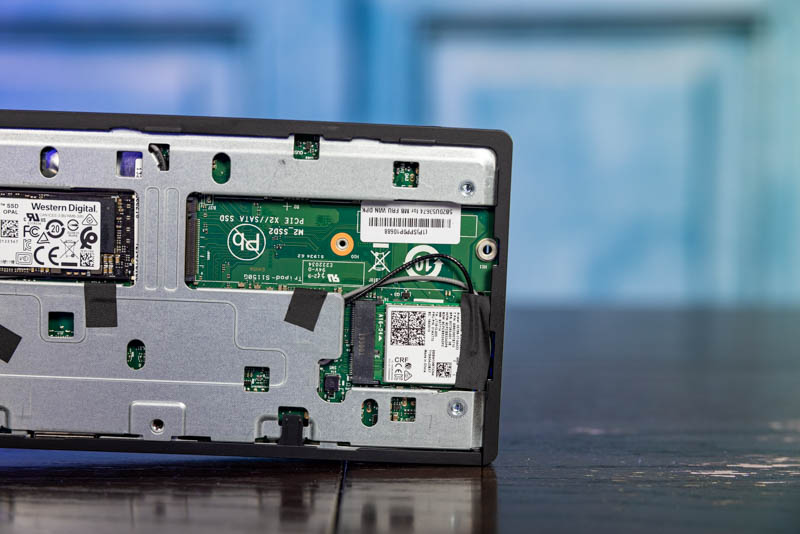
We also have an Intel-based 802.11ac WiFi unit. We purchased this unit new, and at the time, all of the options for the m90n were 802.11ac based on Intel or Realtek. Contemporary Project TinyMiniMicro nodes we purchased usually have newer WiFi 6 802.11ax networking.
Next, we are going to take a look at the key specs, and performance before getting to our power consumption and final words.

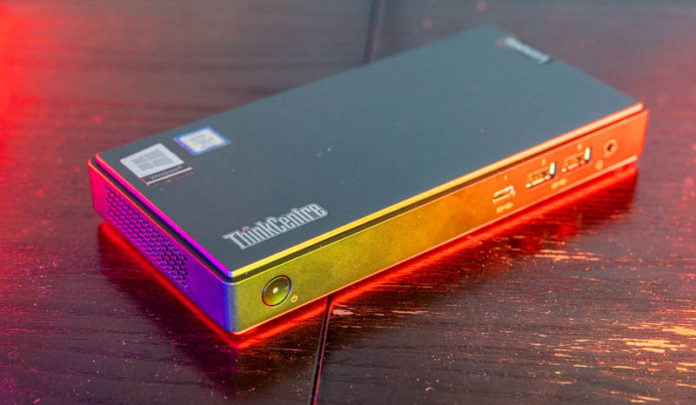



When reviewing a small-form-factor system that is throttling due to inadequate cooling, it would be nice to include a stress test that directly measured FLOPs, clock speed and temperature over time, for example, while running something like high-performance Linpack. Any similar cooling-system stress test wound be welcome.
It’s Wonderful!
I would like to mount the TinyMiniMicro onto camera tripods, analytical/optical benches (lab), to being part of a package attached to physically larger projects e.g. in the observatory, riding the telescope, to having hardwire ether and more compartmentalized for secure lab/facility, performing dedicated function sets e.g. LabVIEW. I also like the USB 3.1 Gen2 port with the less diminutive A like style connector, rather than being limited to a manufacturer selfish and current trend (creates hardware personality matching issues), less robust/inclusive USB 3.1 C.
I’m really puzzled by the design process that would produce something like this.
For laptops you can understand(if not always agree with) thermal compromises because every gram is a gram that the customer will be carrying around a lot; but hyperfocusing on size seems strange for a desktop.
There are definitely “bands” of size/weight that are meaningfully different: some things can be VESA mounted behind the monitor, some can’t; some can be tucked under the monitor, some basically dominate the part of the desk they sit on; but outside of product glamor shots I’m having a hard time thinking of situations where being roughly half the footprint and a little shorter than the ~1L systems helps you. If anything the 1L actually fits in slightly more places because it’s big and robust enough to do things like put a monitor on top of.
The M90n-IoT, at least, is fanless; so its small size doesn’t mean that it’s going to fill with dust and die faster than usual; but with the teeny-fan-whining-for-air version I’m having a hard time thinking of any use case where this is the better option. Why release something like this when the just incrementally larger version would be vastly more useful and no more cumbersome?
Looking forward to the new Lenovo ThinkEdge reviews. SE30 or SE50 would be great.
fuzzyfuzzyfungus is spot on – the size of this system is below the “sweet spot” for small systems. The 1L systems already fit well under a monitor or on a VESA mount. The space savings are even more underwhelming when you consider the external power supply.
With a U-series processor, these fall into the realm of a Chromebook or Chromebox type computer, albeit with a bit more RAM, better networking, and some other nice features. But you can get a Chromebox for around $150 refurbished, making this unit at $400 not a stellar deal. But perhaps for some who absolutely need Windows 10 and absolutely need to keep space to a minimum, this may make sense.
Why not an Intel NUC. I got an NUC8v5PNK with 32GB and a 512GB NvME for around €650 (not bad for European prices).
And it gives me vPRO KVM access, which makes it very attractive as a node server. For the fun of it I’m running an TB GbE connection for storage connection to my nas.